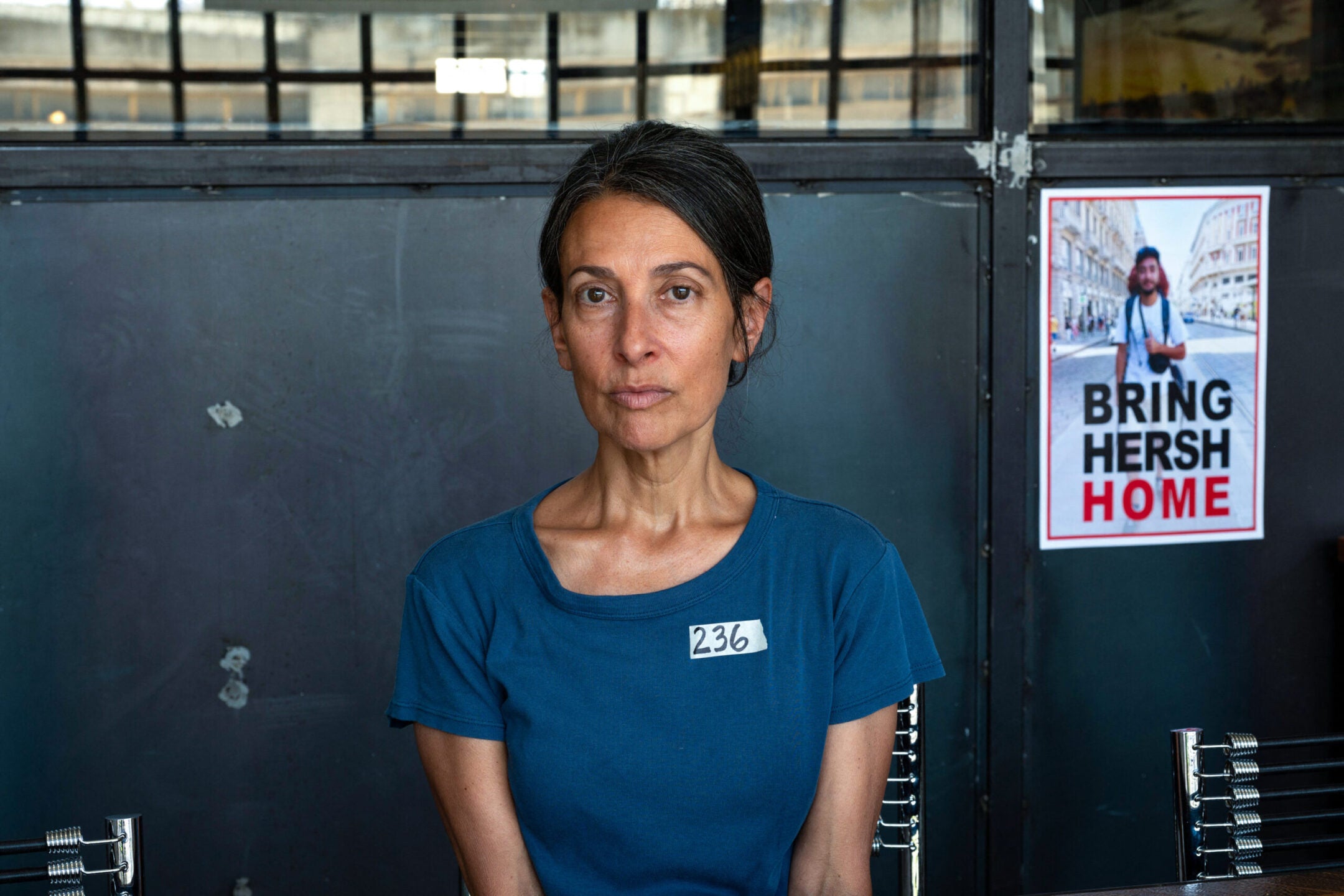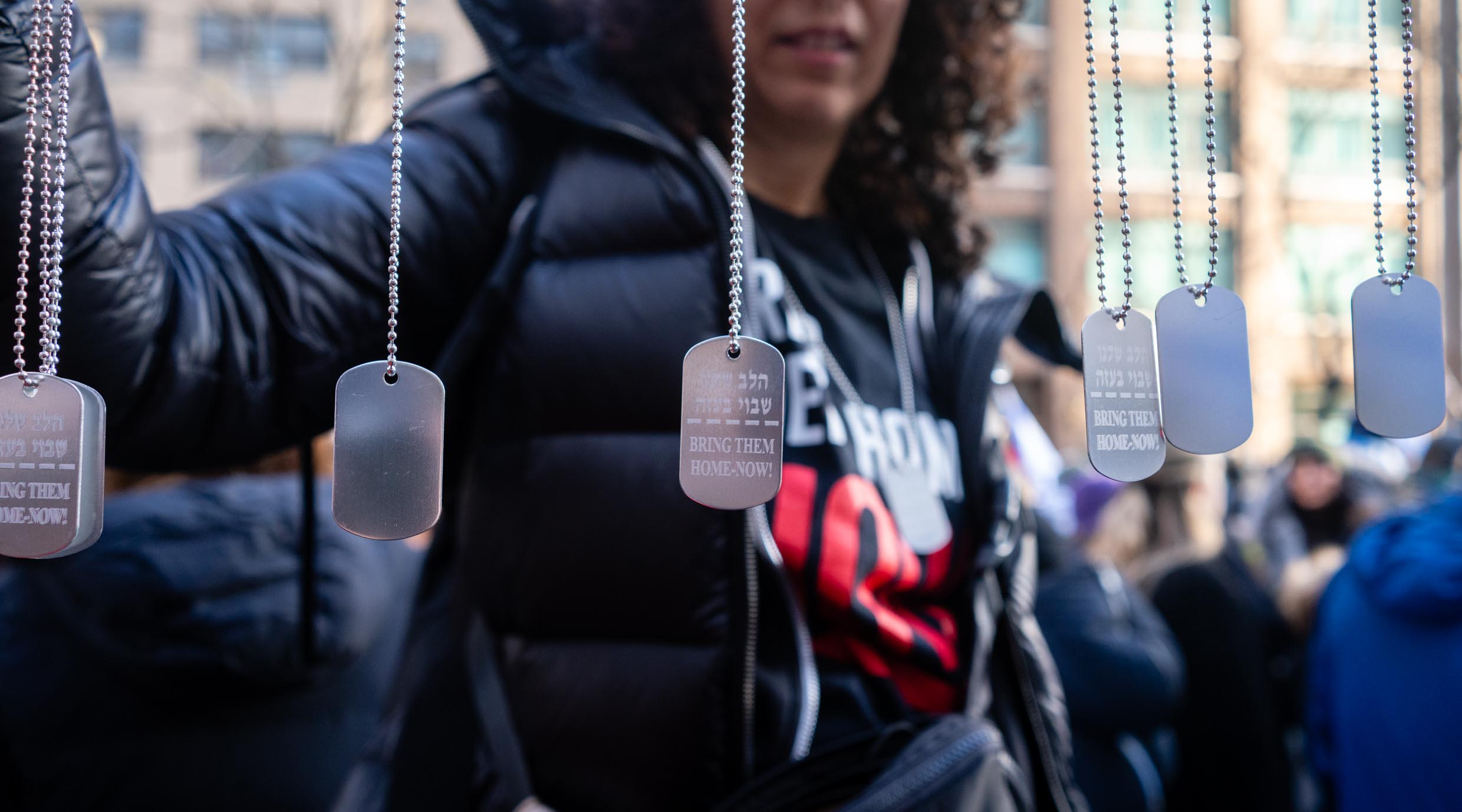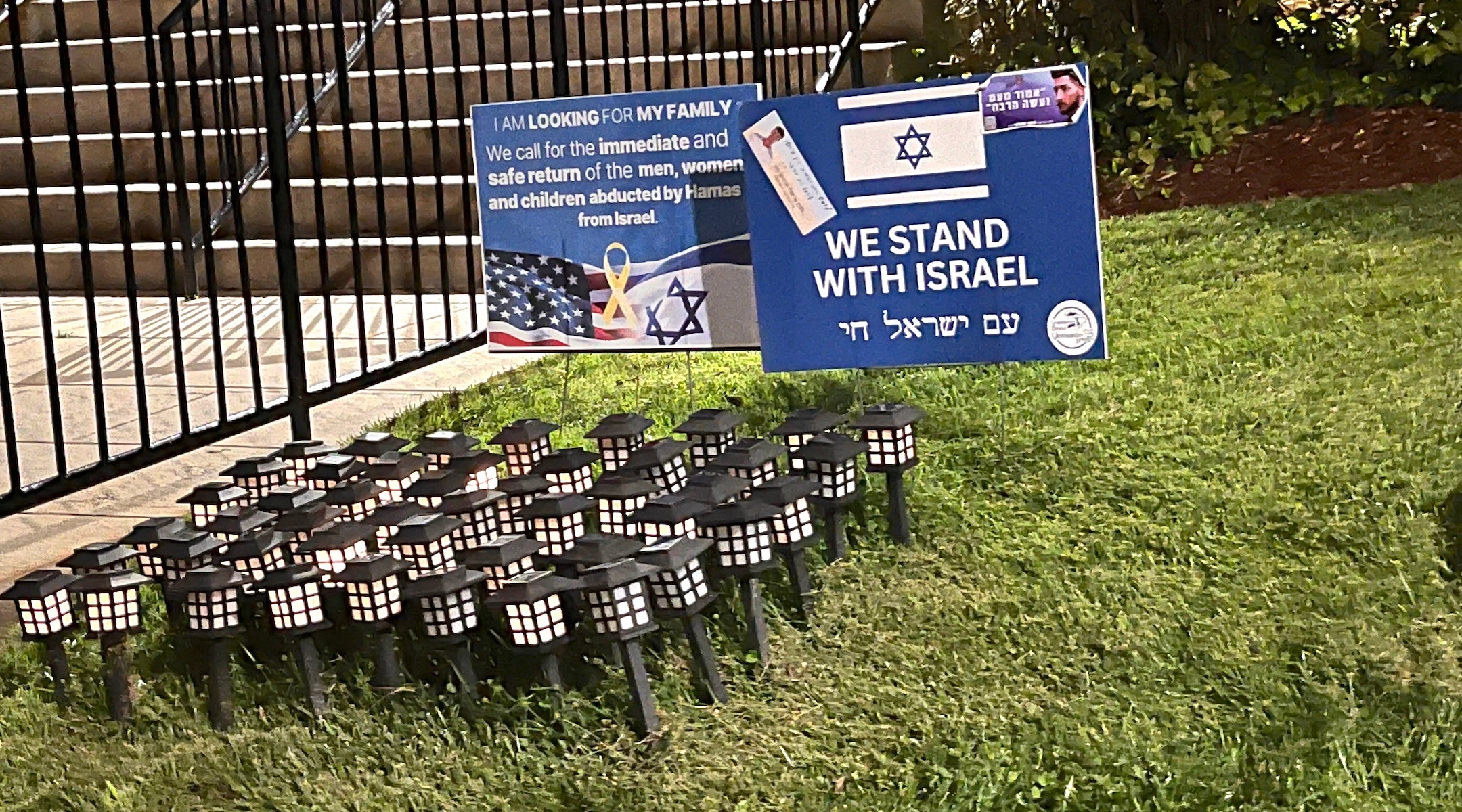Uncategorized
Letting go: Jews retire hostage rituals with gratitude and grief

Like most synagogues, Congregation Beth El in South Orange, New Jersey added new rituals after the Oct. 7, 2023 attacks that killed 1,200 in Israel, saw another 251 taken hostage and launched a grinding war between Israel and Hamas.
The Conservative congregation hung a “bring them home now” sign out front on behalf of the hostages. Rabbi Jesse Olitzky added the “Acheinu” prayer for redeeming captives to the weekly Shabbat service, and each week read the biography of a hostage. As the war raged on, the congregation sang songs of peace.
There and elsewhere, congregants wore yellow hostage ribbons and pins on their lapels, and dog tags with the names of the missing. Some families lit extra candles on Shabbat. Rachel Goldberg-Polin, whose son Hersh would eventually be listed among the dead in Gaza, popularized the wearing of a piece of masking tape on which she wrote the number of days since the hostages were taken.
This week, as the last 20 living hostages were returned to Israel as part of a cease-fire deal between Israel and Hamas, many Jews are relieved to be ending these rituals — even as they question whether it is right to do so and wonder how to channel their prayers and practices toward whatever comes next. Twenty-four deceased hostages are believed to be in Gaza, and even as soldiers return home and Gazans reclaim what’s left of their former lives, an enduring peace seems far away.

Rachel Goldberg-Polin, the mother of Hersh Goldberg-Polin, who was taken hostage by Hamas on Oct. 7, wears a strip of masking tape indicating the number of days that had passed since her son and over 200 people in Israel were taken hostage, May 29, 2024. (Ahikam Seri/AFP via Getty Images)
“Like so many we haven’t been able as a people to move forward and get to Oct. 8 until the hostages came home,” Olitzky said Monday, hours after Hamas released the living hostages. “And now there is a sense of being able to exhale and breathe and, God willing, to move forward, to rebuild, and for all Israeli citizens and for Palestinians to have opportunities to build. peace.”
This week, rabbis and Jews in the pews are asking if it is time to move forward.
Rabbi Yael Ridberg, the recently retired spiritual leader of Congregation Dor Hadash in San Diego, said she would remove the ribbon and dog tag she wears when the bodies of the deceased hostages are returned.
“I look forward to tucking them away, but not disposing of them,” she wrote in response to a journalist’s query. “I will stop wearing them when all the deceased hostages are returned. These are keepsakes of a time worth remembering, as hard as it has been for the last two years.”
Ronit Wolff Hanan, the former music director at Congregation Beth Sholom in Teaneck, New Jersey, said she is not sure what to do with the ribbon pin and dog tags she’s worn for most of the past two years. She’s torn between “this unbelievable release and relief and joy,” and sadness that there are still 24 bodies yet to be returned.
“My whole thing is, well, what do we do know?” said Wolff Hanan, a dual U.S.-Israeli citizen whose son served over 300 days in the Israeli reserves during the war. “I keep thinking about the long, difficult road all of these hostages and families have ahead of them, and it’s just unimaginable. But Also I’m thinking about, when it is really over? We don’t know if this is the dawn of a new era or if we are going to go back to the same old, same old.”
Her partner, Rabbi Eli Havivi, offered his own solution to a similar dilemma: In synagogue on Monday morning, he wore his hostage dog tags, but covered with blue painter’s tape, in order to suggest that “it’s over, but it is not over.”
On a Facebook page for Jewish women, a number of members spoke of their reluctance to stop lighting extra candles. Some felt that if they did, it would break a kind of spiritual commitment, or might suggest that they’ve given up on the freed hostages who will continue to have mental and physical challenges. Some referred to a passage from Talmud (Shabbat 21b) that extends the metaphor of the Hanukkah candles to suggest that someone should always add light, not subtract.
By contrast, the comic Periel Aschenbrand wrote that she was eager to take off the button that she’d been wearing in solidarity with Omri Miran, a hostage abducted in front of his wife and two children on Oct. 7. “I can’t wait to be able to take it off tomorrow, and for Omri to be reunited with his daughters and family,” she wrote Sunday on Instagram.
Alyssa Goldwater, an Orthodox influencer, wrote that she too is “really looking forward” to taking off the yellow ribbon pin she’s worn over the past two years, but that removing doesn’t mean forgetting.
“When you remove a pin, the tiny holes never fully go away,” she wrote on Instagram. “They will remain and serve as a reminder that we will never forget what has happened to us over the last two years. We will never forget who stood by us and who stood soundly or against us. The holes will be tiny because we pray that the hostages will be able to eventually heal and live their regular lives again, where the unimaginable travesties they’ve been through won’t even be noticeable in the human eye, but the holes will remain, because this is a part of us now.”
Long before Oct. 7 led to a torrent of new practices, Jews altered their prayers and rituals in tune with current events, with some changes handed down from rabbis and others bubbling up from the “folk.”
Some changes stick — like the Av HaRachamim memorial prayer, composed in the Middle Ages for those who perished in the Crusades – and others fall away. In the 1970s and ’80s boys and girls celebrating their b’nai mitzvah “twinned” with Soviet Jews unable to emigrate. Adults wore silver bracelets with the name of these refuseniks, and put them away when the emigration restrictions fell.

Dog tags in support of Hamas hostages at a rally near the U.N., Jan. 12, 2024. (Luke Tress)
The additions and changes that persist usually speak to other events, the way Av HaRachamim has become a weekly reminder of various Jewish tragedies. In general, however, a prayer or ritual that responds to current events “should have a theoretical timestamp for when it exits stage left, even if we cannot always know when that time will come,” Rabbi Ethan Tucker, president and rosh yeshiva of Hadar, explained in a Facebook post discussing the transition away from Oct. 7 practices. “Without that foresight and planning, the addition either straggles on, eventually becoming a kind of exhibit in the gallery of prayer, or it simply fades away when monotony and detachment have gotten the better of it.”
The Jewish calendar itself seemed to conspire in the spiritual turbulence of many Jews: The hostage release came on the eve of Israelis’ celebration of Simchat Torah — and the second anniversary, on the Hebrew calendar, of the Hamas attacks.
The holiday is meant to be a day of unbridled joy. A centerpiece of Simchat Torah is the hakafah, when congregants repeatedly dance with and around the Torah scrolls
Last year, congregations struggled with how to match the happy themes of the holiday with the one-year anniversary of the worst attack in Israel’s history. Olitzky said his congregation began last year’s Simchat Torah rituals with a “solemn” hakafah, where congregants sang Israel’s national anthem and a somber Hebrew song while standing still. Olitzky said he took solace last year in the words of Goldberg-Polin, who said, “’There is a time to sob and a time to dance’ and we have to do both right now.”
And while the release of the hostages is also tinged with sadness — for the lost years, the captives who didn’t make it, the suffering still to come – many will use the holiday as a celebration of deliverance and gratitude.
The release of the hostages, Olitzky said, will “allow Simchat Torah to be that — the holiday when we are supposed to have so much joy. Last year it was difficult to find that joy on Simchat Torah. I truly believe that we will have a greater opportunity in the days ahead to sing and dance.”
Adat Shalom, a Reconstructionist synagogue in Bethesda, Maryland, will use Simchat Torah to celebrate the hostages’ return by ending another common practice since Oct. 7: a chair left empty on the synagogue’s bima, featuring the image of a missing hostage.
During the dancing on Simchat Torah, marked on Tuesday night outside of Israel, the congregation will bring the chair to the dancing, and use it to lift up members wedding-style. “We have a lot of people in the community who are really close with the Hostages and Missing Families Forum in Washington,” said Rabbi Scott Perlo. “We’re going to take that very chair, and take it from its depths and lift it up, and make it the centerpiece of our joy.”

A synagogue in Teaneck, New Jersey displays lanterns representing the hostages still alive in Gaza and the bodies of those who are also slated to be returned under a deal between Israel and Hamas, Oct. 8, 2025. (JTA photo)
Adat Shalom rotated in a number of special prayers and readings over the past two years, acknowledging, Perlo said ruefully, that “there’s so much to pray for,” including “the hostages, the safety of our family in Israel, the safety of people in Gaza,” and the state of American democracy.
He understands that some congregants may be wary of letting go of the new rites and prayers — perhaps afraid that if they don’t keep up the tradition, the horrors that prompted their prayers will only return.
“So what I would say to them is some version of, ‘Yes, don’t let it go completely, but let it transform into something new,’” said Perlo.
Rabbi Felipe Goodman of Temple Beth Sholom in Las Vegas, Nevada also plans to incorporate a ritual of release and transformation during Simchat Torah celebrations on Tuesday night. He’s asking congregants to bring their yellow pins and dog tags and place them on an heirloom Torah cover. “This cover will be dedicated as a memorial and displayed at the entrance of our Temple, so that every time we walk through through Our Temple’s doors, we will remember what happened on Oct. 7, 2023,” he wrote in message to members.
On Sunday, Hanna Yerushalmi, a rabbi based in Annapolis, Maryland, shared a poem on Instagram, called “Yellow Chairs,” that imagined a near future in which hope will transform the fraught symbols of Oct. 7 grief and remembrance. It reads in part:
Empty chairs will be
saved for friends arriving late,
and tape will be
tape again,
and hostage necklaces
will be put away, forgotten in drawers.
and Saturday night will be date night once again.
—
The post Letting go: Jews retire hostage rituals with gratitude and grief appeared first on Jewish Telegraphic Agency.
Uncategorized
Iran Opposes Grossi’s UN Secretary-General Candidacy, Accuses Him of Failing to Uphold International Law

UN nuclear watchdog chief Rafael Grossi holds a press conference on the opening day of the International Atomic Energy Agency’s (IAEA) quarterly Board of Governors meeting in Vienna, Austria, Sept. 8, 2025. Photo: REUTERS/Elisabeth Mandl
Iran has publicly opposed International Atomic Energy Agency (IAEA) Director-General Rafael Grossi’s potential appointment as UN Secretary-General next year, accusing him of failing to uphold international law by not condemning US and Israeli strikes on Iranian nuclear sites during the 12-day war between Iran and Israel in June.
During a UN Security Council meeting on Monday, Iran’s Ambassador to the UN, Amir Saeid Iravani, sharply criticized Grossi, calling him unfit” to serve as UN Secretary-General next year, Iranian media reported.
“A candidate who has deliberately failed to uphold the UN Charter — or to condemn unlawful military attacks against safeguarded, peaceful nuclear facilities … undermines confidence in his ability to serve as a faithful guardian of the charter and to discharge his duties independently, impartially, and without political bias or fear of powerful states,” the Iranian diplomat said.
With UN Secretary-General Antonio Guterres’ term ending in December next year, member states have already begun nominating candidates to take over the role ahead of the expected 2026 election.
Since the start of the war in Gaza, Israel’s relationship with Guterres has spiraled downward, reaching a low point last year when then-Foreign Minister Israel Katz labeled the UN “antisemitic and anti-Israeli” and declared Guterres persona non grata after the top UN official failed to condemn Tehran for its ballistic missile attack against the Jewish state.
Last week, Argentina officially nominated Grossi to succeed Guterres as the next UN Secretary-General.
To be elected, a nominee must first secure the support of at least nine members of the UN Security Council and avoid a veto from any of its five permanent members — the United States, China, Russia, the United Kingdom, and France.
Afterward, the UN General Assembly votes, with a simple majority needed to confirm the organization’s next leader.
As head of the UN’s nuclear watchdog since 2019, Grossi has consistently urged Iran to provide transparency on its nuclear program and cooperate with the agency, efforts the Islamist regime has repeatedly rejected and obstructed.
Despite Iran’s claims that its nuclear program is solely for civilian purposes rather than weapons development, Western powers have said there is no “credible civilian justification” for the country’s nuclear activity, arguing it “gives Iran the capability to rapidly produce sufficient fissile material for multiple nuclear weapons.”
With prospects for renewed negotiations or nuclear cooperation dwindling, Iran has been intensifying efforts to rebuild its air and defense capabilities decimated during the 12-day war with Israel.
On Monday, Mohammad Eslami, head of the Atomic Energy Organization of Iran (AEOI), declared that the IAEA has no authority to inspect sites targeted during the June war, following Grossi’s renewed calls for Tehran to allow inspections of its nuclear sites and expand cooperation with the agency.
Iran has also announced plans to expand its nuclear cooperation with Russia and advance the construction of new nuclear power plants, as both countries continue to deepen their bilateral relations.
According to AEOI spokesperson Behrouz Kamalvandi, one nuclear power plant is currently operational, while other two are under construction, with new contracts signed during a recent high-level meeting in Moscow.
Kamalvandi also said Iran plans to build four nuclear power plants in the country’s southern region as part of its long-term partnership with Russia.
During a joint press conference in Moscow on Tuesday, Iranian Foreign Minister Abbas Araghchi reiterated Iran’s commitment to defending the country’s “legal nuclear rights” under the now-defunct 2015 nuclear deal, noting that Tehran’s nuclear policies have remained within the international legal framework.
Iran’s growing ties with Russia, particularly in nuclear cooperation, have deepened in recent years as both countries face mounting Western sanctions and seek to expand their influence in opposition to Western powers.
Russia has not only helped Iran build its nuclear program but also consistently defended the country’s “nuclear rights” on the global stage, while opposing the imposition of renewed economic sanctions.
Russian Foreign Minister Sergey Lavrov has described the reinstatement of UN sanctions against Iran as a “disgrace to diplomacy.”
In an interview with the Islamic Republic of Iran News Network (IRINN), Lavrov accused European powers of attempting to blame Tehran for the collapse of the 2015 nuclear deal, despite what he described as Iran’s compliance with the agreement.
Prior to the 12-day war, the IAEA flagged a series of Iranian violations of the deal.
Uncategorized
Eurovision Host Says It Will Not Drown Out Any Boos During Israel’s Performance

ORF executive producer Michael Kroen attends a press conference about the Eurovision Song Contest in Vienna, Austria, Dec. 16, 2025. Photo: REUTERS/Lisa Leutner
The host broadcaster of the next Eurovision Song Contest, Austria’s ORF, will not ban the Palestinian flag from the audience or drown out booing during Israel’s performance as has happened at previous shows, organizers said on Tuesday.
The 70th edition of the contest in May will have just 35 entries, the smallest number of participants since 2003, after five national broadcasters including those of Spain, Ireland, and the Netherlands said they would boycott the show in protest at Israel’s participation.
What is usually a celebration of national diversity, pop music, and high camp has become embroiled in diplomatic strife, with those boycotting saying it would be unconscionable to take part given the number of civilians killed in Gaza during Israel’s military campaign following the Palestinian terrorist group Hamas’s Oct. 7, 2023, invasion of and massacre across southern Israel.
“We will allow all official flags that exist in the world, if they comply with the law and are in a certain form – size, security risks, etc.,” the show’s executive producer, Michael Kroen, told a news conference organized by ORF.
“We will not sugarcoat anything or avoid showing what is happening, because our task is to show things as they are,” Kroen said.
AUSTRIA SUPPORTED ISRAEL PARTICIPATING
The broadcaster will not drown out the sound of any booing from the crowd, as happened this year during Israel’s performance, ORF’s director of programming Stefanie Groiss-Horowitz said.
“We won’t play artificial applause over it at any point,” she said.
Israel’s 2025 entrant, Yuval Raphael, was at the Nova music festival that was a target of the Hamas-led attack. The CEO of Israeli broadcaster KAN had likened the efforts to exclude Israel in 2026 to a form of “cultural boycott.”
ORF and the Austrian government were among the biggest supporters of Israel participating over the objections of countries including Iceland and Slovenia, which will also boycott the next contest in protest. ORF Director General Roland Weissmann visited Israel in November to show his support.
This year’s show drew around 166 million viewers, according to the European Broadcasting Union, more than the roughly 128 million who Nielsen estimates watched the Super Bowl.
The war in Gaza began after Hamas-led terrorists killed 1,200 people, most of them civilians, and seized 251 hostages in an attack on southern Israel.
Uncategorized
Antisemitism Allowed to Fester in Australia, Says Daughter of Wounded Holocaust Survivor

Victoria Teplitsky, daughter of a Holocaust survivor who was wounded at the Bondi shootings, stands at a floral memorial in honor of the victims of the mass shooting targeting a Hanukkah celebration on Sunday, at Bondi Beach, in Sydney, Australia, Dec. 16, 2025. Photo: REUTERS/Jeremy Piper
Government authorities have not done enough to stamp out hatred of Jews in Australia, which has allowed it to fester in the aftermath of Oct. 7, said the daughter of a Holocaust survivor who was wounded at the Bondi shootings on Sunday.
Victoria Teplitsky, 53, a retired childcare center owner, said that the father and son who allegedly went on a 10-minute shooting spree that killed 15 people had been “taught to hate,” which was a bigger factor in the attack than access to guns.
“It’s not the fact that those two people had a gun. It’s the fact that hatred has been allowed to fester against the Jewish minority in Australia,” she told Reuters in an interview.
“We are angry at our government because it comes from the top, and they should have stood up for our community with strength. And they should have squashed the hatred rather than kind of letting it slide,” she said.
“We’ve been ignored. We feel like, are we not Australian enough? Do we not matter to our government?”
The attackers fired upon hundreds of people at a Jewish festival during a roughly 10-minute killing spree, forcing people to flee and take shelter before both were shot by police.
RISING ANTISEMITIC ATTACKS
Antisemitic incidents have been rising in Australia since the war in Gaza erupted after Palestinian terrorist group Hamas killed 1,200 Israelis in an attack on Oct. 7, 2023.
A rise in such incidents in the past sixteen months prompted the head of the nation’s main intelligence agency to declare that antisemitism was his top priority in terms of threat.
“This was not a surprise to the Jewish community. We warned the government of this many, many times over,” Teplitsky said.
“We’ve had synagogues that have been graffitied, graffiti everywhere, and we’ve had synagogues that have been bombed,” she added, referring to a 2024 arson attack in Melbourne in which no one was killed.
Teplitsky’s father Semyon, 86, bled heavily after being shot in the leg, and now is facing several operations as doctors piece bone back together with cement, then remove the cement from the leg, which he still may lose, she said.
“He’s in good spirits, but he’s also very angry. Angry that this happened, that this was allowed to happen in Australia, the country that he took his children to, to be safe, to be away from antisemitism, to be away from Jew hatred.”
Israel’s Prime Minister Benjamin Netanyahu said on Monday that Australian Prime Minister Anthony Albanese “did nothing” to curb antisemitism.
Albanese repeated on Tuesday Australia‘s support for a two-state solution. Anti-Israel, pro-Hamas protests have been common in Australia since Israel launched its offensive in Gaza.
At a press briefing on Monday, Albanese read through a list of actions his government had taken, including criminalizing hate speech and incitement to violence and a ban on the Nazi salute. He also pledged to extend funding for physical security for Jewish community groups.


